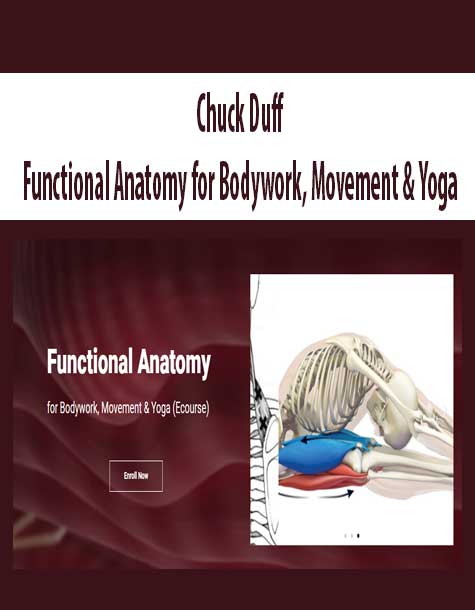Description
Chuck Duff – Functional Anatomy for Bodywork, Movement & Yoga | Instant Download !
PLEASE CHECK ALL CONTENTS HERE:
The Essential Knowledge for Treating Pain!
Many therapists forget much of the anatomy they learned in school because they don’t use it. CTB therapists use anatomy and trigger point knowledge every day to understand and treat the sources of pain and movement dysfunction. It is a living knowledge.
If we understand the true action and function of each muscle in the body, we understand what activities would be limited by that muscle (daily activities, yoga postures, etc.), how it might be likely to get into trouble, and how to contract and stretch it.
One must become fluent with how to find, palpate, lengthen and shorten muscles, the problems they cause, pain referral and their relationships with other muscles.
Our Functional Anatomy course was developed to provide the essential muscle knowledge that is the foundation of the CTB treatment approach.
Hi – I’m Chuck Duff, Founder of Coaching The Body Institute.
Oddly enough, pain is a mystery to the medical profession. Our medical system is still in the middle ages in terms of understanding pain, which is why we have over 65,000 people a year dying of opiate overdose in the US.
Sadly, a high percentage of addicts begin with a prescribed opiate, and much of it is unnecessary. Pain is assumed by the medical establishment to always be a product of injury or disease, but this is just plain wrong.
I’m a trigger point therapist, and it has been demonstrated in repeated studies as well as my own 15 years of clinical experience that the vast majority of pain is from muscles that have developed trigger points.
I have great success in my work, and the foundation of that success is the understanding of how muscles function and how they become dysfunctional and refer pain.
This Functional Anatomy course provides the essential knowledge that informs the CTB treatment approach.
Trigger Points: Extremely Common and Easily Addressed
Trigger points, which are actually responsible for most pain, are small areas of stagnation in muscle tissue that develop in response to chronic or acute stresses on muscles.
They aren’t injuries, but they commonly send pain to other areas (pain referral) in a way that can feel very much like an injury. This fools everyone – doctors, PTs, most practitioners.
While the pain can be severe and limit movement, trigger points are fairly easy to correct. The techniques aren’t difficult – what’s important is knowing what muscles are referring pain, how to locate the trigger points, and how to shorten and lengthen the muscles to change the experience of pain and increase range of motion. This can be accomplished in manual therapy or movement therapy settings.
Previous
Next
Functional Anatomy: Five Essential Areas of Muscle Knowledge
In order to address trigger point behavior and resolve pain, there are some key areas of muscle knowledge that any therapist must know.
These areas are covered in-depth in this course in over 10 hours of lecture and demonstration video.
1 – Pain referral (direct & satellite), symptoms, false diagnoses.
2 – How to locate / isolate / palpate muscles.
3 – Innvervations & entrapments.
4 – Actions, relationships, contract / relax.
5 – Function & perpetuation.
Trigger Points: Extremely Common and Easily Addressed
Trigger points, which are actually responsible for most pain, are small areas of stagnation in muscle tissue that develop in response to chronic or acute stresses on muscles.
They aren’t injuries, but they commonly send pain to other areas (pain referral) in a way that can feel very much like an injury. This fools everyone – doctors, PTs, most practitioners.
While the pain can be severe and limit movement, trigger points are fairly easy to correct. The techniques aren’t difficult – what’s important is knowing what muscles are referring pain, how to locate the trigger points, and how to shorten and lengthen the muscles to change the experience of pain and increase range of motion. This can be accomplished in manual therapy or movement therapy settings.
Previous
Next
Functional Anatomy: Five Essential Areas of Muscle Knowledge
In order to address trigger point behavior and resolve pain, there are some key areas of muscle knowledge that any therapist must know.
These areas are covered in-depth in this course in over 10 hours of lecture and demonstration video.
1 – Pain referral (direct & satellite), symptoms, false diagnoses.
2 – How to locate / isolate / palpate muscles.
3 – Innvervations & entrapments.
4 – Actions, relationships, contract / relax.
5 – Function & perpetuation.



